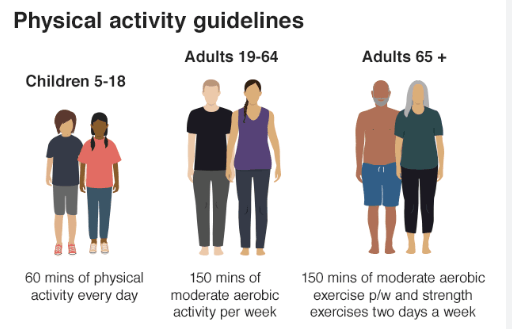Step Up Your Fitness Game with a Pedometer – Learn How to Stay Active and Healthy Now

Physical inactivity is a well-known global health challenge, with approximately 5 million deaths each year attributed to lack of exercise. The World Health Organization recommends at least 150 minutes of moderate-intensity physical activity per week for adults aged 18–64 years to maintain good health. However, despite these recommendations, many people struggle to find the motivation or time to engage in regular physical activity.
One tool that has gained popularity in recent years for promoting physical activity is the pedometer. A pedometer is a simple device that counts the number of steps taken while walking or running and can be worn on clothing or as part of a wristwatch.
Studies have shown that using a pedometer can significantly increase daily step counts and promote physical activity by providing feedback on progress towards goals and encouraging individuals to incorporate more walking into their daily routine.
This article will discuss how using a pedometer can promote a physically active lifestyle by exploring the benefits of walking, setting realistic goals, incorporating walking into daily routines, making walking more enjoyable, and combining walking with other forms of exercise.
Understanding the Benefits of Walking
An examination of the literature suggests that there are numerous health benefits associated with regular walking, making it an effective way to promote physical activity.
Walking has been shown to improve cardiovascular health, decrease the risk of chronic diseases such as diabetes and heart disease, and even improve mental well-being.
To maximize these benefits, it is important to use proper walking techniques such as keeping a brisk pace and maintaining good posture.
By understanding the benefits of walking and utilizing proper techniques, individuals can take control of their physical health and well-being while promoting a more active lifestyle.
What is a Pedometer?
One tool that can provide an accurate measurement of daily movement is a pedometer.
A pedometer is a small device that records the number of steps taken by an individual throughout the day. It works by detecting and measuring the motion of the hips, which indicates walking or running activity.
Pedometers are often clipped onto clothing or worn on the wrist like a watch. The device has become increasingly popular in recent years due to its ability to accurately measure physical activity levels and promote an active lifestyle.
By setting goals and tracking progress, individuals can monitor their daily steps and strive to increase their overall physical activity level for improved health outcomes.
Setting Realistic Goals
Setting realistic goals is a crucial step towards achieving optimal physical activity levels and improving overall health outcomes. When using a pedometer, it is important to set goals that are achievable yet challenging enough to promote progress.
Start by tracking daily steps for one week to establish a baseline level of activity. From there, set a goal to increase daily steps by 10% each week until reaching the recommended 10,000 steps per day.
It is also helpful to break down larger goals into smaller, more manageable ones such as taking short walks during lunch breaks or parking further away from destinations to increase walking distance.
By setting realistic goals and tracking progress with a pedometer, individuals can gradually increase their physical activity levels and improve overall health outcomes.
Incorporating Walking into Your Daily Routine
Incorporating physical activity into our daily routines is crucial for maintaining good health and preventing chronic diseases. Walking is a simple and effective way to increase physical activity levels, and can easily be incorporated into various daily activities.
This subtopic will focus on three key strategies for incorporating walking into your daily routine:
- Walking to work or school
- Taking walking breaks throughout the day
- Using lunch breaks as an opportunity for physical activity.
Walking to Work or School
Walking to work or school can be an effective way to increase daily physical activity levels, as it offers a convenient opportunity to incorporate walking into one’s daily routine. Research studies have shown that individuals who walk to work or school tend to have higher physical activity levels compared to those who commute using private vehicles.
Walking with pets or friends can also be an enjoyable way to make the experience more engaging. It is recommended that individuals aim for at least 30 minutes of moderate-intensity physical activity per day, and walking for transportation purposes can contribute towards meeting this goal.
Moreover, walking instead of driving may not only benefit one’s health but also reduce traffic congestion and air pollution, hence promoting environmental sustainability. Therefore, incorporating walking into one’s daily routine by choosing active modes of transportation such as walking can lead to numerous health benefits and help promote a physically active lifestyle.
Walking During Lunch Breaks
Research studies have demonstrated that taking a break from work through walking during lunchtime can offer significant physical and mental health benefits.
Here are four reasons why individuals should consider incorporating lunchtime walks into their routine:
1) Walking can boost energy levels and productivity, allowing individuals to return to work with a clearer mind and increased focus.
2) It is an easy way to incorporate physical activity into the day, contributing towards the recommended daily amount of exercise.
3) Outdoor walks in nature have been shown to reduce stress levels and improve mood.
4) Regular participation in lunchtime walks can promote socialization among coworkers, fostering positive relationships within the workplace.
Despite these benefits, there may be challenges in finding time or motivation for lunchtime walks. Tips for staying motivated include setting achievable goals, finding a walking partner/accountability buddy, and varying routes or destinations to keep things interesting.
Overall, incorporating lunchtime walks into daily routines can provide numerous benefits both physically and mentally for individuals in the workplace.
Taking Walking Breaks Throughout the Day
The effectiveness of taking walking breaks throughout the day for improving work productivity and reducing sedentary behavior is a topic of interest in workplace health research.
Several studies have shown that incorporating brief bouts of physical activity into the workday can lead to increased energy levels, improved mood, and enhanced cognitive function.
Additionally, taking walking breaks has been associated with reduced risks of chronic diseases such as obesity and cardiovascular disease.
To stay motivated, individuals can use strategies such as setting goals for steps per hour or finding a walking buddy to hold themselves accountable.
Employers can also promote the benefits of walking breaks by providing resources such as pedometers or creating designated walking paths on company grounds.
Overall, incorporating regular physical activity into the workday through taking walking breaks offers numerous benefits for both individual employees and organizations as a whole.
Tips for Making Walking More Enjoyable
Enhancing the experience of walking can facilitate long-term adherence to a physically active lifestyle.
Creative routes and walking with friends are two ways that can make walking more enjoyable. Taking a different route each time one goes for a walk can add variety to the exercise, making it less monotonous and more engaging.
Walking with friends can also make the activity more social and fun, which may increase motivation for regular physical activity.
Additionally, listening to music or podcasts while walking may further enhance the experience by providing entertainment or distraction from any discomfort associated with exercise.
By incorporating these tips into daily habits, individuals may find that they are more likely to maintain an active lifestyle in the long run.
Combining Walking with Other Forms of Exercise
Incorporating walking into a regular exercise routine can be an effective way to improve overall health and fitness. However, combining walking with other forms of exercise can further enhance the benefits.
Strength training exercises, such as weightlifting or bodyweight workouts, can help build muscle mass and increase metabolism.
Yoga or Pilates can improve flexibility and balance while promoting relaxation and stress relief.
Finally, cycling or swimming can provide low-impact cardiovascular exercise that complements the benefits of walking.
By combining different types of exercise, individuals may experience improved physical performance and overall well-being.
Strength Training Exercises
One effective way to improve overall physical fitness and health is to include strength training exercises in a daily exercise routine.
Strength training exercises, also known as resistance exercises, are designed to increase muscle strength and endurance by using external resistance such as body weight or resistance bands. These exercises can be performed anywhere without the need for expensive equipment or gym memberships.
Examples of bodyweight exercises include push-ups, squats, lunges, and planks while using resistance bands can add variety to your workout routine by targeting specific muscle groups.
Incorporating strength training into a regular exercise regimen not only helps build lean muscle mass but also improves bone density, posture, balance, and metabolism. Therefore, it is crucial to integrate these types of exercises into one’s daily routine for long-term health benefits.
Yoga or Pilates
Yoga and Pilates are low-impact exercises that can improve flexibility, balance, and core strength.
Yoga involves holding poses for extended periods of time while focusing on breathing techniques.
On the other hand, Pilates focuses on controlled movements to strengthen the core muscles.
A study conducted on elderly adults found that regular participation in yoga classes improved their balance and reduced the risk of falls.
In addition, both yoga and Pilates can complement walking recovery by promoting muscular endurance and relaxation.
Some of the best yoga poses for walking recovery include downward-facing dog, warrior I and II, tree pose, and camel pose.
Practicing these poses regularly can help individuals recover from a long walk or hike by stretching tight muscles, improving circulation, and calming the mind.
Overall, incorporating yoga or Pilates into a daily routine can promote physical activity while also providing numerous health benefits such as increased flexibility and reduced stress levels.
Cycling or Swimming
Cycling and swimming are both excellent forms of low-impact exercise that can improve cardiovascular health and endurance.
While cycling is a great way to build leg strength, swimming provides a full-body workout that is easy on the joints.
Both activities offer numerous benefits for overall health, including improved weight management, lower blood pressure, and reduced risk of chronic diseases such as heart disease and diabetes.
Water workouts in particular have been shown to be effective for managing pain associated with conditions such as arthritis and fibromyalgia.
Ultimately, the choice between cycling and swimming depends on personal preference and individual fitness goals. However, incorporating either activity into a regular exercise routine can promote a physically active lifestyle that leads to improved overall health and well-being.
Conclusion
In conclusion, the use of a pedometer can effectively promote a physically active lifestyle. This device allows individuals to track their daily steps and progress towards realistic goals.
Walking is an accessible and low-impact form of exercise that offers numerous health benefits, including improved cardiovascular health, weight management, and reduced risk of chronic diseases. By incorporating walking into one’s daily routine and making it more enjoyable through various techniques such as listening to music or walking with friends, individuals can increase their physical activity levels without feeling overwhelmed or burdened.
Furthermore, combining walking with other forms of exercise such as strength training or yoga can provide a well-rounded fitness regimen. In essence, using a pedometer not only helps individuals become more aware of their physical activity levels but also encourages them to take small steps towards leading a healthier lifestyle.
As the saying goes, ‘a journey of a thousand miles begins with a single step.’ With the help of a pedometer and determination to make positive changes in one’s life, anyone can embark on this journey towards better health and wellness.




